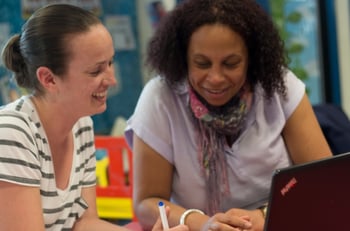 Starting a new job as a Deputy Headteacher is a daunting task, especially when the title includes words such as ‘responsible for’ and ‘quality & standards’.
Starting a new job as a Deputy Headteacher is a daunting task, especially when the title includes words such as ‘responsible for’ and ‘quality & standards’.
My mind went into overdrive after securing the position at Oriel High School, as the enormity of the task ahead set in. Assuring the quality of teaching across approximately 100 individuals and securing continuous improvement in outcomes for around 1,400 students made herding cats seem like an easy task!
It’s not that the teaching in the school wasn’t already good. In fact, I’m very fortunate to work with a very talented, hard-working and reflective staff body; but aligning the work of a large number of people, whilst remaining relevant to the needs of each individual, presented a real set of diverse challenges.
Where should I start as a deputy head?
I started with a clear understanding of the strong correlation between teacher quality and student outcomes.
Research indicates that engaging in ‘instructional leadership’ has a strong positive impact on sustained teacher learning and student achievement.
This was summarised by Viviane Robinson in her 2011 book, Student Centered Leadership. Her argument is simple: improve teacher quality to improve student outcomes.
The task ahead was starting to increase in clarity.
What should I work towards?
Having established what the task was, my next challenge was how to go about contunously improving teaching quality.
In 2013, at the ‘Raising the Quality of Teaching’ event co-organised by the Teacher Development Trust, Sir Tim Brighouse concisely communicated a summary of Judith Little’s work, identifying some of the key things to work towards achieving:
“You know you are in a good school when:
Teachers talk about teaching.
Teachers observe each other’s practice.
Teachers plan, organise and evaluate their work together.
Teachers teach each other.”
Further reflection and research around instructional leadership provided clarity about the true meaning of the phrase; ‘providing opportunity for developing the quality of instruction’ not ‘telling people how to do it’!
The key task became defined as increasing the professional capital of staff.
Increasing the professional capital of staff
This required the development of a culture that:
- Promoted trust
- Provided opportunities for collaboration
- Believed in the power of people to do great things and be creative, effective problem solvers
Successfully supporting the development of this culture seemed to provide an opportunity to accelerate teacher learning and development for the benefit of the students we work with.
A central and underpinning idea in creating this vision was that teacher learning and development was presented not as a ‘you need to’ but ‘we are all trying to continuously improve because we could be better.’
Accelerating teacher learning and development
This was a gradual process that involved a number of discreet but interrelated elements, all contributing towards the desired shift in culture.
Changing culture can be a difficult and time consuming pr ocess but reading the work of John Kotter certainly helped in this area. An initial step that paved the way for further developments was a shift to a more collegiate, faculty structure.
ocess but reading the work of John Kotter certainly helped in this area. An initial step that paved the way for further developments was a shift to a more collegiate, faculty structure.
This allowed a greater number of leaders within the organisation, all able to contribute to and influence organisational progress, by influencing and shaping the professional learning of staff within their teams.
Although there have been a number of iterations in what we do and how we do it, we have consistently remained true to the four key principles outlined by Sir Tim Brighouse.
Using Tim Brighouse's 4 principles to facilitate opportunities
Key activities we undertook to contribute towards the creation of this culture were:
1. Removal of lesson grading
For staff to be willing to engage in developmental lesson observation, for their own and other’s benefit, the stigma of grading had to be removed. All the time a judgement was attached, it stymied the developmental opportunity from an observation. With lesson grading removed, the sole focus of observation became about helping teachers learn and develop.
We have had to overcome issues surrounding judging teacher effectiveness. However, our ability to effectively judge the quality of learning and teaching over time, accurately identifying areas of strengths and areas for development at both organisational and individual levels, has improved.
2. Recognising and valuing risk taking in the appraisal process
Staff have been encouraged to pursue autonomous developmental targets that are phrased for mastery, for innovation and for performance. The core purpose of all of these self-derived targets is to develop practice to improve outcomes for students.
Key actions for achieving the 4 principles
1. Teachers talking about teaching
An opportunity for staff to engage in high quality professional learning
Making sure staff are able to engage in and recognise, high quality professional learning that is personalised and relevant has raised its status, value and impact. The range of opportunities for conversation, collaboration and feedback are broad and include both formal and informal opportunities.
The rationale behind providing a diverse range of opportunities is that; needs are diverse within a large staff body and one size fits all learning is not an effective or empowering methodology for the sustainable improvement of teacher quality. It is the desire to provide this high quality learning that has led to the organising of an annual conference #EducatEd2016 and regular collaborative events such as Film Club.
2. Teachers observing each other’s practice
Encouraging observation of self and others
To achieve this, we started by deploying IRIS Connect as a tool that facilitated self-reflection. Once staff were comfortable with this, the opportunities for collaboration and development were explored further. 
Initially staff were unsure about the use of video in individual lessons but, after viewing recordings of themselves, the frequency of teachers making use of the equipment has rapidly increased and the conversations it has promoted are invaluable to supporting teacher development.
All our teaching staff have access to an IRIS Connect account. In the next academic year, this will be expanded to include all support staff working with students in a learning setting. It is difficult to see how true self-reflection could occur without this tool. More recently all teachers have been asked to observe a colleague for the observers’ benefit. i.e. ‘I am coming to watch you because I want to learn from you, not judge you’
3. Teachers planning, organising and evaluating their work together
Engaging with the Teacher Development Trust
Making use of the CPD audit tool was very useful in having a blueprint to work towards. Accepting that this is a stringent document, and that achieving progress towards the standards is a process measured in years rather than weeks, is a useful way of approaching it.
Undertaking the audit, with the associated staff surveys and facilitated peer reflection was of great benefit in providing support and challenge to the leadership of teacher learning and development. Of immense value in creating opportunities for staff to collaborate and problem solve was the introduction of lesson study as a high value, high status, professional learning opportunity. Our work in this area is still growing but the cultural benefits to the organisation beyond the actual findings of the lesson study are significant.
4. Teachers teaching each other
This has been a culmination of the activities undertaken above. The ability for teachers to reflect and engage with colleagues in a non-judgmental way has had a profound impact upon teacher learning. We have been careful to try not to be too prescriptive in how this should or could occur. Importantly, our aim has been to provide a toolkit and opportunities for this to happen. We have accepted that a slower, more organic solution is probably more sustainable than being imposing or didactic.
In the current climate, issues surrounding recruitment & retention are starting to affect all schools. However, our belief is that our commitment to professional learning has helped support staff to do their job to the best of their ability. When recruiting, we work hard to find people who have a strong cultural fit and have the capacity and willingness to work hard and to improve both in the short and longer term.
Our focus on and successes in supporting teachers to develop has increased retention rates amongst high quality members of staff and helped new entrants (ITT / Schools Direct / NQT) to the profession to positively start their journey towards securely developing into master practitioners. All schools experience staff turnover but our experience is one of people moving on for promotion and development rather than dissatisfaction, which can only be a good thing!
The impact
The progress made by the organisation has been a collective endeavour; something that we all contribute towards. This in no way reduced levels of accountability; instead of it being an externally imposed agenda it became internalised and invested in by individual staff members.
The accountability audience has evolved – the value added to students for their benefit has become more of a key driver, rather than accountability within a line management structure.
The function of line management is to assume devolved responsibility for the accountability audience, providing challenge on their behalf rather than for self-centred benefit. This has been an important element of our journey; the recognition from teachers in the part they are able to play in a student’s future opportunities has become a central thread that runs through the staff body.
Do you have any questions for Tim? Leave them below or tweet him @purplepedagogy



Leave a comment:
Get blog notifications
Keep up to date with our latest professional learning blogs.